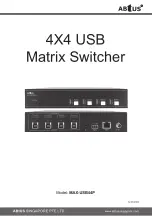
IPv6 Commands
619
OL-32830-01 Command Line Interface Reference Guide
27
If an entry for the specified IPv6 address already exists in the neighbor discovery
cache, learned through the IPv6 neighbor discovery process, the entry is
automatically converted to a static entry.
Static entries in the IPv6 neighbor discovery cache are not modified by the
neighbor discovery process.
Use the no ipv6 neighbor
ipv6-address
interface-id
command to remove the one
given static entry on the given interface. The command does not remove the entry
from the cache, if it is a dynamic entry, learned from the IPv6 neighbor discovery
process.
Use the no ipv6 neighbor
interface-id
command to delete the all static entries on
the given interface.
Use the no ipv6 neighbor command to remove the all static entries on all
interfaces.
Use the
show ipv6 neighbors
command to view static entries in the IPv6 neighbor
discovery cache. A static entry in the IPv6 neighbor discovery cache can have one
of the following states:
•
NCMP (Incomplete)—The interface for this entry is down.
•
REACH (Reachable)—The interface for this entry is up.
Note. Reachability detection is not applied to static entries in the IPv6 neighbor
discovery cache; therefore, the descriptions for the INCMP and REACH states are
different for dynamic and static cache entries.
Examples
Example 1. The following example configures a static entry in the IPv6 neighbor
discovery cache for a neighbor with the IPv6 address 2001:0DB8::45A and
link-layer address 0002.7D1A.9472 on VLAN 1:
switchxxxxxx(config)#
ipv6 neighbor
2001:0DB8::45A vlan1 0002.7D1A.9472
Example 2. The following example deletes the static entry in the IPv6 neighbor
discovery cache for a neighbor with the IPv6 address 2001:0DB8::45A and
link-layer address 0002.7D1A.9472 on VLAN 1:
switchxxxxxx(config)#
no ipv6 neighbor
2001:0DB8::45A vlan1
Summary of Contents for 300 Series
Page 2: ......
















































